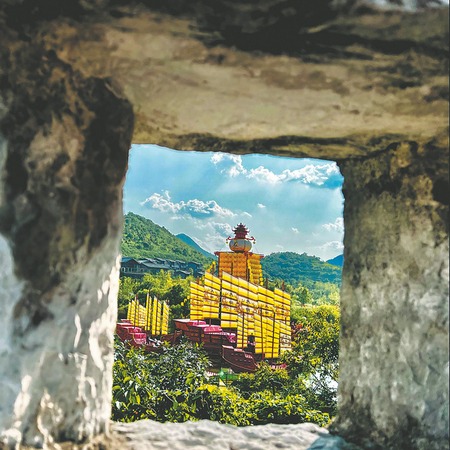


A Ming Dynasty (1368-1644) military post in rural Guizhou may not be a place you'd expect to board a 4D army tank ride to battle virtual reality-generated flying skulls, snapping crocodiles and striking cobras. Or to walk through an art installation simulating outer space where strings of lights of various colors and shapes dangle in rooms with mirrors on the walls, ceilings and floors, summoning a sense of cosmic infinity.
You can't help but walk into these suspended "heavenly bodies", putting miniature multiverses into motion at the Starry Sky Art Museum.

But travelers who explore Qingyan ancient town in Guizhou province's capital Guiyang will discover that this small, centuries-old settlement offers many digitally generated activities that appeal to vast worlds beyond its borders and our planet — and much more.
Yet the six-century-old cobblestone settlement still sustains traditions from previous eras.
Ethnic Miao artisans hammer ornate silver teapots, bracelets and bowls into shape on stumps along the street sides.
Eateries serve local specialties, such as ethnic Miao-style tofu balls, stewed pig trotters, rice jelly and the namesake Qingyan tofu, washed down with red bayberry juice.

Travelers can stroll through ancient manors belonging to military leaders and temples honoring Confucius and Wenchang — the deity of literature — and stand atop the parapet-studded and canon-laden city wall. Qingyan, throughout various periods, was home to Taoists, Buddhists, Catholics and Protestants. Today, it hosts nine monasteries, eight temples, five pavilions and two ancestral halls that testify to its evolution since its initial construction in 1378.
The garrison continued to serve its military functions through the 20th century.
It was integral in extinguishing two major uprisings during the Ming Dynasty, in 1458 and 1622 and the Taiping Rebellion in the Qing Dynasty (1644-1911); it contributed to the revolution against China's last emperor, which ended feudal rule in China; and, during the War of Liberation (1946-49), it served as a decoy target for the Red Army, who feigned an assault on Guiyang and covertly rerouted to Yunnan.

The Zhao Ancestral Hall displays weapons, equipment, wax figures and photos from the numerous battles Qingyan sustained over the centuries.
Life-size replicas of ancient warships drift across a lotus pond just outside the city walls, reminding visitors of the martial legacy that could hardly be forgotten by the descendants of soldiers who inhabit this peaceful place forged by war.
erik_nilsson@chinadaily.com.cn
If you have any problems with this article, please contact us at app@chinadaily.com.cn and we'll immediately get back to you.